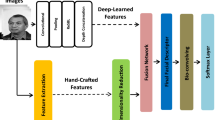Abstract
Biometric systems with traits like gesture, voice, fingerprint, palm print, handwritten signature, hand geometry, face, and iris have been utilized for authentication. Through these traits, face trait is considered as one of the strongest and an important biometric element. In this work, a presentation of a new cancellable algorithm of face image which is dependent on AlexNet and Winner-Takes-All (WTA) hash method has been proposed. AlexNet is a Convolutional Neural Networks (CNNs) that reached a state-of-the-art level of recognition precision compared to other conventional machine learning methods in terms of feature execution. WTA is used for similarity purposes, whereas random binary orthogonal matrices are applied to produce the projected features of vectors. Fundação Educacional Inaciana dataset and Georgia tech face dataset were used in evaluating the performance of the proposed algorithm. Experimental results illustrate the proposed algorithm has satisfactory execution performance in terms of Equal Error Rate. Thus the proposed algorithm can be used as an alternative method in security biometric implementation.
Access this chapter
Tax calculation will be finalised at checkout
Purchases are for personal use only
Similar content being viewed by others
References
Das, S., et al.: Lip biometric template security framework using spatial steganography. Pattern Recogn. Lett. (2018). https://doi.org/10.1016/j.patrec.2018.06.026
Awad, A.I.: From classical methods to animal biometrics: a review on cattle identification and tracking. Comput. Electron. Agric. 123, 423–435 (2016). https://doi.org/10.1016/j.compag.2016.03.014
Ali, Z., Hoossain, M.S., Muhammad, G., Ullah, I., Abachi, H., Alamri, A.: Edge-centric multimodal authentication system using encrypted biometric template. Future Gener. Comput. Syst. 85, 76–87 (2018). https://doi.org/10.1016/j.future.2018.02.040
Amirthalingam, G., Radhamani, G.: New chaff point based fuzzy vault for multimodal biometric cryptosystem using particle swarm optimization. J. King Saud Univ.-Comput. Inf. Sci. 28, 381–394 (2016). https://doi.org/10.1016/j.jksuci.2014.12.011
Wong, W.J., Teoh, A.B., Kho, Y.H., Wong, M.D.: Kernel PCA enabled bit-string representation for minutiae-based cancellable fingerprint template. Pattern Recogn. 51, 197–208 (2016). https://doi.org/10.1016/j.patcog.2015.09.032
Ratha, N.K., Chikkerur, S., Connell, J.H., Bolle, R.M.: Generating cancelable fingerprint templates. IEEE Trans. Pattern Anal. Mach. Intell. 29, 561–572 (2007). https://doi.org/10.1109/TPAMI.2007.1004
Nguyen, K., Fookes, C., Sridharan, S., Tistarelli, M.: Super resolution for biometrics: a comprehensive survey. Pattern Recogn. 78, 23–42 (2018). https://doi.org/10.1016/j.patcog.2018.01.002
Sarier, N.D.: Multimodal biometric identity based encryption. Future Gener. Comput. Syst. 80, 112–125 (2018). https://doi.org/10.1016/j.future.2017.09.078
Chee, K.-Y., Jin, Z., Cai, D., Li, M., Yap, W.-S., Lai, Y.-L.: Cancellable speech template via random binary orthogonal matrices projection hashing. Pattern Recogn. 76, 273–287 (2018). https://doi.org/10.1016/j.patcog.2017.10.041
Krizhevsky, A., Sutskever, I., Hinton, G.E.: ImageNet classification with deep convolutional neural networks. In: 25th International Conference on Neural Information Processing Systems (NIPS 2012), pp. 1097–1105 (2012)
Yagnik, J., Strelow, D., Ross, D.A., Lin, R.-S.: The power of comparative reasoning. In: IEEE International Conference on Computer Vision, pp. 2431–2438. IEEE Press, New York (2011). https://doi.org/10.1109/iccv.2011.6126527
Jin, Z., Teoh, A.B., Goi, B.-M., Tay, Y.-H.: Biometric cryptosystems: a new biometric key binding and its implementation for fingerprint minutiae-based representation. Pattern Recogn. 56, 50–62 (2016). https://doi.org/10.1016/j.patcog.2016.02.024
Wang, S., Yang, W., Hu, J.: Design of alignment-free cancelable fingerprint templates with zoned minutia pairs. Pattern Recogn. 66, 295–301 (2017). https://doi.org/10.1016/j.patcog.2017.01.019
Murakami, T., Ohki, T., Takahashi, K.: Optimal sequential fusion for multibiometric cryptosystems. Inf. Fusion 32, 93–108 (2016). https://doi.org/10.1016/j.inffus.2016.02.002
Dwivedi, R., Dey, S., Singh, R., Prasad, A.: A privacy-preserving cancelable iris generation schema using decimal encoding and look-up table mapping. Comput. Secur. 65, 373–386 (2017). https://doi.org/10.1016/j.cose.2016.10.004
Umer, S., Dhara, B.C., Chandra, B.: A novel cancelable iris recognition system based on feature learning techniques. Inf. Sci. 406–407, 102–118 (2017). https://doi.org/10.1016/j.ins.2017.04.026
Lai, Y.-L., et al.: Cancellable iris template generation based on indexing-first-one hashing. Pattern Recogn. 64, 105–117 (2017). https://doi.org/10.1016/j.patcog.2016.10.035
Dwivedi, A., Kumar, S., Dwivedi, A., Singh, M.: Cancellable biometrics for security and privacy enforcement on semantic web. Int. J. Comput. Appl. 21, 0975–8887 (2018). https://doi.org/10.5120/2535-3460
Yang, W., Wang, S., Zheng, G., Valli, C.: Impact of feature proportion on matching performance of multi-biometric system. ICT Express 5, 37–40 (2018). https://doi.org/10.1016/j.icte.2018.03.001
Khan, S.H., Akbar, M.A., Shah-Zad, F., Farooq, M., Khan, Z.: Secure biometric template generation for multi-factor authentication. Pattern Recogn. 48, 458–472 (2015). https://doi.org/10.1016/j.patcog.2014.08.024
Kaur, H., Khanna, P.: Gaussian random projection based non-invertible cancelable biometric templates. Comput. Sci. 54, 661–670 (2015). https://doi.org/10.1016/j.procs.2015.06.077
Roy, S.S., Ahmed, M., Akhand, M.A.H.: Noisy image classification using hybrid deep learning methods. J. Inf. Commun. Technol. 17, 233–269 (2018)
Alom, M.Z., et al.: The History Began from Alexnet: A Comprehensive Survey on Deep Learning Approaches. ArXivabs/1803.01164 (2018). n. pag
Suh, H.K., Ijsselmuiden, J., Hofstee, J.W., Henten, E.J.: Transfer learning for the classification of sugar beet and volunteer potato under field conditions. Biosyst. Eng. 174, 50–65 (2018). https://doi.org/10.1016/j.biosystemseng.2018.06.017
Fu, Y., Aldrich, C.: Froth image analysis by use of transfer learning and convolutional neural networks. Miner. Eng. 115, 68–78 (2018). https://doi.org/10.1016/j.mineng.2017.10.005
Bai, C., Huang, L., Pan, X., Zheng, J., Chen, S.: Optimization of deep convolutional neural network for large scale image retrieval. Neurocomputing 303, 60–67 (2018). https://doi.org/10.1016/j.neucom.2018.04.034
Artificial Intelligence Laboratory of FEI. https://fei.edu.br/~cet/facedatabase.html
Centre for Signal and Image Processing. http://www.anefian.com/research/face_reco.htm
Cherifi, F., Hemery, B., Giot, R., Pasquet, M., Rosenberger, C.: Performance evaluation of behavioral biometric systems. In: Behavioral Biometrics for Human Identification: Intelligent Applications, IGI Global Disseminator of Knowledge, vol. 21 (2009). https://doi.org/10.4018/978-1-60566-725-6.ch003
Acknowledgements
The researchers thank the Malaysian Ministry of Higher Education for subsidizing this investigation under Fundamental Research Grant Scheme, S/O code 12490.
Author information
Authors and Affiliations
Corresponding author
Editor information
Editors and Affiliations
Rights and permissions
Copyright information
© 2020 Springer Nature Switzerland AG
About this paper
Cite this paper
Alwan, H.B., Ku-Mahamud, K.R. (2020). Cancellable Face Biometrics Template Using AlexNet. In: Khalaf, M., Al-Jumeily, D., Lisitsa, A. (eds) Applied Computing to Support Industry: Innovation and Technology. ACRIT 2019. Communications in Computer and Information Science, vol 1174. Springer, Cham. https://doi.org/10.1007/978-3-030-38752-5_27
Download citation
DOI: https://doi.org/10.1007/978-3-030-38752-5_27
Published:
Publisher Name: Springer, Cham
Print ISBN: 978-3-030-38751-8
Online ISBN: 978-3-030-38752-5
eBook Packages: Computer ScienceComputer Science (R0)




